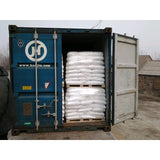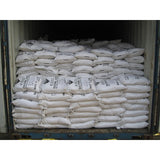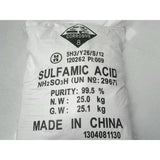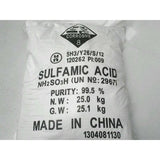Sulphamic Acid / Sulfamic Acid 99.5%
This colorless water-soluble molecular compound finds use in diverse applications listed below:
- Cleaning agent – to clean metals and ceramics. Also used to remove rust or as a descaling. Sulphamic acid is sometimes used as an ingredient in corrosion inhibitors.
- Ingredient for fire extinguishing media.
- Pulp and paper industry as a chloride stabilizer.
- Herbicide.
Sulfamic acid is used:
- For the cleaning of industrial equipment from mineral deposits (hardness, oxide films, iron compounds), from milk-stone and beer-stone.
- In catering and at home: for processing the dining room and kitchen utensils.
- In the production of household chemicals (detergents, cleansers).
- As a raw material in the synthesis of chemicals: for refractory materials, for obtaining herbicides.
- In electroplating: to prepare the electrolyte, pickling food tin.
- To remove the mucus from the water-cooling systems (pools).
- When cleaning the paper machine.
- In the treatment of the bottom-hole zone of oil wells to increase oil recovery.
- In the production of phenol-formaldehyde resins.
- In the manufacture of emulsion explosives
Advantages of
As compared with previously used in the industry acidic cleaners, such as hydrochloric acid and nitric acid, sulfamic acid produced in dry crystalline form, which greatly simplifies the process and reduces the cost of its transportation, storage, and use.
In addition, sulphamic acid is the less corrosive agent in comparison with hydrochloric and nitric acids.
Synonyms: Glacial acetic acid; Acetic acid solution; acetic acid 50%; acetic acid, of a concentration of more than 10 per cent, by weight, of acetic acid; Acetic Acid Glacial BP; Natural Acetic Acid; Acetic acid (36%); Acetic acid, food grade; Acetic Acid Glacial; GAA; Acetic Acid, Glacial
It is a colourless liquid that when undiluted is also called glacial acetic acid. It has a distinctive sour taste and pungent smell.
Acetic acid uses: Additive in industrial explosives in Mining.
Other uses include use of acetic acid in the production of vinyl acetate monomer, acetic anhydride and ester production.
Chemical gassing agents -In the case of emulsion explosives, using Acetic acid can accelerate the gassing process. The chemically gassed emulsions may take 40 – 50 minutes for completion of gassing within the blast holes, particularly when the emulsion is colder.
In cases where acetic acid is used, it is added to the emulsion prior to gassing, the desired amount of acid is mixed in the emulsion, before adding the gasser.
A gassing solution comprising sodium nitrite in water together with the selected enol compound and acetic acid is introduced into the emulsion explosive at the blast hole by entraining the gassing solution into a stream of the emulsion explosive using pumps.
The solution pH is an important parameter in the gassing of emulsion explosives due to the high cost associated with acid addition therefore a pH value should preferably be maintained at 4.1 or below.
|
Identifiers |
|
|
Abbreviations |
AcOH |
|
CAS number |
64-19-7 |
|
PubChem |
176 |
|
ChemSpider |
171 |
|
UNII |
Q40Q9N063P |
|
EC number |
200-580-7 |
|
UN number |
2789 |
|
Properties |
|
|
Molecular formula |
C2H4O2 |
|
Molar mass |
60.05 g mol |
|
Appearance |
Colourless liquid |
|
Odor |
Pungent/Vinegar-like |
|
Density |
1.049 g cm |
|
Melting point |
16 to 17 °C; 61 to 62 °F; 289 to 290 K |
|
Boiling point |
118 to 119 °C; 244 to 246 °F; 391 to 392 K |
|
Solubility inwater |
Miscible |
|
Acidity (pKa) |
4.76 |
|
Basicity (pKb) |
9.198 (basicity of acetate ion) |
|
Refractive index(nD) |
1.371 |
|
Viscosity |
1.22 mPa s |
|
Dipole moment |
1.74 D |
1- TRANSPORT INFORMATION
- Transport-UN 2789
- Hazard Class No. : 8
- Packing Group: II
- H.S. Code: 2915211900
2- STORAGE & HANDLING
- Stable at room temperature in closed containers under normal STORAGE & HANDLING and handling conditions. Refer to SDS sheet
3- PACKING
|
Packing type |
Tons/FCL |
|
IBC Drums |
18tons/FCL |
|
30kg Drums |
21tons/FCL |
|
200Kg drums |
16tons/FCL |
4.Environmental impact
- Acetic acid biodegrades readily under both aerobic and anaerobic conditions.
- Acetic acid does not absorb light with wavelengths >290 nm(4), and is not expected to be susceptible to direct photolysis by sunlight(SRC).
- Incase of spillage neutralize spill with soda ash or lime.
5. Download our Acetic acid msds for more handling information.










